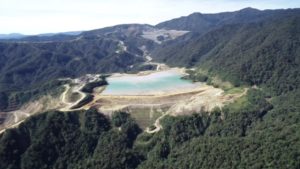Use of Drones at Harmony’s Hidden Valley Mine
July 15, 2020 |
KCB regularly uses a light-weight drone to collect high-quality images and videos from elevated platforms for routine embankment construction monitoring activities at the Hidden Valley mine site in Papua New Guinea. The drone, which belongs to our client, Harmony subsidiary Morobe Consolidated Goldfields Limited, provides a number of benefits to KCB field staff working in remote locations of the mine site, such as the Hidden Valley tailings storage facility (TSF), including:
- Improved confidence in assessing earthworks compliance against design, based on visual evidence;
- Safer monitoring opportunities where field staff access is constrained by topographical or other reasons;
- The ability to confirm ground conditions and earthwork construction activity in remote areas before attempting to access such areas which can be cumbersome and time consuming;
- Rapid visual assessment of key areas following large rainfall or earthquake events; and,
- Improved monitoring ability as large areas can be covered quickly, and data can be compared where repetitive data collection exists.

KCB also uses the drone field data to integrate with LiDAR and survey data collected by a survey drone. The survey drone is a larger unit than the equipment used by KCB for routine monitoring because it is required to carry a larger payload at altitudes of 2,000-2,500 metres above sea-level and be able to collect field data for longer periods of time.
KCB has experienced a number of challenges using the small drone at the Hidden Valley mine site, some of them unexpected:
- The light-weight drone performs remarkably well in moderate wind and light rainfall. However, it is always preferable to use this equipment in fine weather conditions as platform stability is linked to data quality;
- When trespassers are unexpectedly encountered, they have used slingshots to try to chase the drones away;
- Birds of prey breeding near the TSF are aggressive and territorial, and it is not uncommon for the kites on site to attack the drone if it flies into their territory; and,
- The drone is small and white and is surprisingly difficult to see in the distance, especially under overcast conditions. This is also the case when the drone is used at night. The “return home” function provides a lot of confidence to recover the instrument in such situations.
